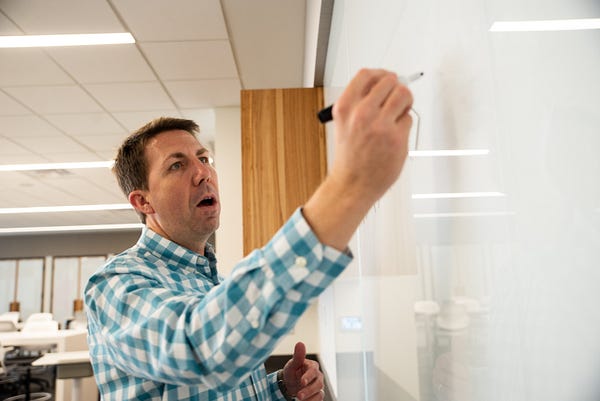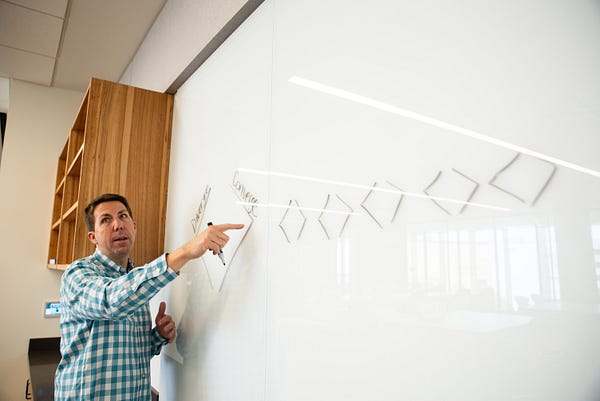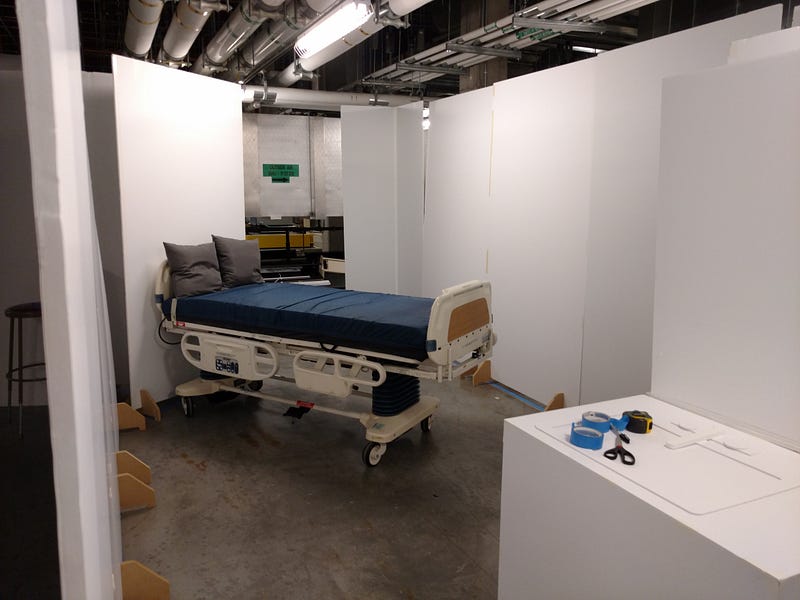More or Less: Why Timing is Key to Your Team’s Creative Success
For creative teams, knowing when to stop brainstorming is crucial.
By Jeremy M. Simon

Senior marketing lecturer Stephen Walls steps up to a classroom whiteboard and draws the symbols for “greater than” and “less than.” It’s his shorthand way of signaling to MBA students in his course what to expect in a brainstorming session: when it’s time to generate more ideas, and when to pick a specific idea and move forward to the next phase, such as building a prototype product.
The distinction is one of the most important concepts that Walls teaches in his classes on design thinking at the McCombs School of Business. The popular problem-solving approach, with its origins in the 1960s, has expanded beyond professional designers and into corporate offices. It emphasizes creating solutions for the people who will eventually use a product or service, using research, interviews, and observation.
For project teams, seeing either a “greater than” or “less than” symbol written on a whiteboard gets everyone on the same page — introducing the difference between divergent and convergent thinking. Over time, these phases resemble the shape of an accordion, alternating repeatedly between widening and narrowing. During the divergent thinking phase, team members add as much as possible to possible solutions: brainstorming new ideas, conducting research to collect lots of data, or proposing numerous problem-solving approaches. Then, in the convergent phase, the teams narrow down things and choose how to proceed, perhaps by defining the challenge to be addressed, selecting a single solution, or creating a prototype to test out.
Picture an advertising team that comes up with long list of slogans, but then has to select just one sentence for their campaign.
“The difference between divergent and convergent thinking is huge. It’s a game changer in terms of how I work, and especially how I work with teams because that’s where the real value comes in.” — Stephen Walls
Individuals tend to favor one of those approaches, but each has its own challenges. Some people are natural “divergers” who can’t make up their minds and continue introducing ideas even when it’s time for a decision, says Walls. Others are “convergers” who want to decide quickly and move forward.


Designing at Dell Medical School
How does the distinction play out in the real world? When the design team at UT Austin’s Dell Medical School was envisioning a new type of patient examination room, team members proposed room concepts with varying seating and signage, for example.
The challenge: determining which version patients and health care providers would prefer.
Once the Design Institute for Health, an embedded design team at Dell Med, had generated plenty of concepts, the group needed to work to narrow their options. Toward that goal, the team created a full-size prototype room made out foam board, paperboard, and epoxy. Once the protoype was built out, providers and patients were able to walk through the space and see if the environment encouraged patients to actively participate in their own care, rather than simply accepting the treatment prescribed for them.
Building out the room required a shift from divergent to convergent thinking. “Divergence is about new ideas, but creating things is an act of making a choice,” says Beto Lopez, director, systems designer, and co-founder of the Design Institute for Health, a joint venture of the Dell Medical School and the College of Fine Arts at The University of Texas at Austin.
Know Your Phase
Dell Med is just one institution that has embraced design thinking. It’s being applied elsewhere on campus, too, at the less than two-year old Center for Integrated Design in the College of Fine Arts. “It’s a method that is human centered, so it’s based on understanding two questions: What’s the problem we’re really trying to solve? And who are we solving that problem for?” says Doreen Lorenzo, the center’s executive director and assistant dean for the School of Design and Creative Technologies at UT Austin.
“It’s always based on the person who’s going to interact with your solution, so you’re constantly testing and prototyping to get a better product or service.” — Doreen Lorenzo
For Walls, the distinction between divergent and convergent is hugely important. He encourages teams to try the simple act of drawing the “greater than” and “less than” symbol on a whiteboard. Team members can then see what phase of the project they’re working on. Do they need to provide more ideas? Or do they need to build out one specific idea? “That’s not revelatory, but what teams mistakenly do over and over is not realize what phase they’re in,” Walls says.
Team members can then contribute accordingly. “That changes team dynamics instantly,” he says. “In fact, I feel so strongly about it, I now tell people, ‘What I’m about to tell you will change your life forever.’”
In Dell Med’s process of design, the team decided that rather than figuring out the number of seats needed for the waiting room, they’d bypass having a waiting room altogether. Patients would get their own rooms — and health care specialists would come to them.
The team considered including a chair (to ease patient anxiety) that could convert into an exam table over a minute’s time. “Divergent thinking was coming up with a whole bunch of different ways to design the room. We could easily generate a multitude of ideas to improve the experience,” says Kat Jones, director of strategy and mission for the Design Institute.
By prototyping the room and inviting health care practitioners to step inside, the team learned that doctors were concerned about the waiting time required for the chair to become an exam table. But the team members reminded themselves that patient care was the top priority.
“If we hadn’t built that prototype, we wouldn’t have addressed the business model,” says Lopez. By enabling the team to experience a three-dimensional prototype, it helped them advocate for changes to benefit patient care alongside business considerations.

Living in Beta
Over the course of a project, the phases can alternate many times. For example, a team may begin with a high-level question, then diverge into multiple ways they can conduct the necessary research, before converging again on the research tools needed to get answers. Once data has been collected, the analysis phase is again divergent, as the team considers all the conclusions that follow from the research. The analysis process then marks further convergence, as key insights are gleaned.
Deadlines or cost often determines when teams need to move from diverging to converging. Constraints of time and money can hold teams back from diverging indefinitely — they eventually have to make a choice. Design thinking allows for that. If the team picks a solution that they later realize doesn’t work, they can go back to an earlier phase and diverge again to generate other ideas. “If what you converge on isn’t the right thing for whatever reason, you can always loop back around and start diverging and converging again to get to a better result,” explains Walls.
Dell Med relies on that approach. “It’s living in beta, this idea that we’re never satisfied with the way it’s built,” says Lopez of the exam room. “We’re always asking, ‘How can we continue to improve the experience between the provider team and the patient?’ Divergence and convergence never stops,” he says. Even after the room was constructed, the team added arrows to help direct patients to the clinic exit.


